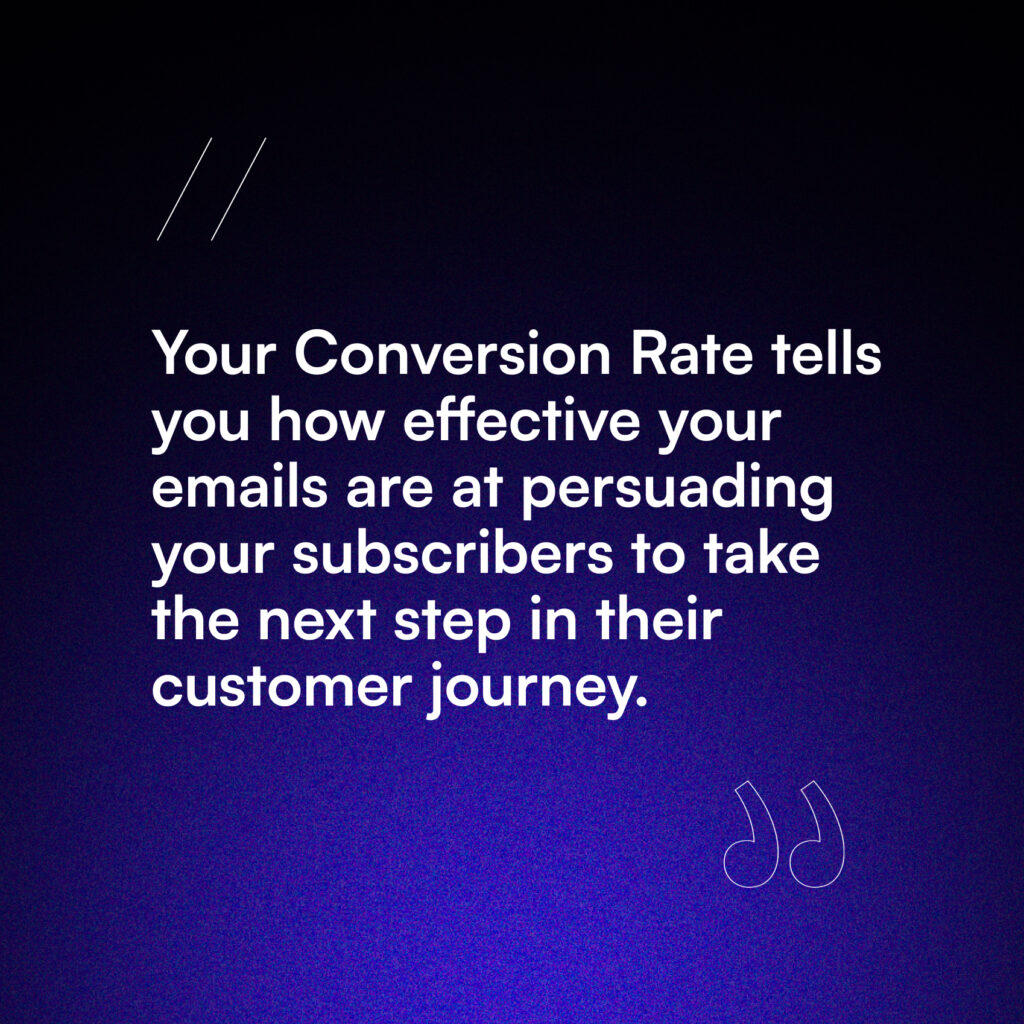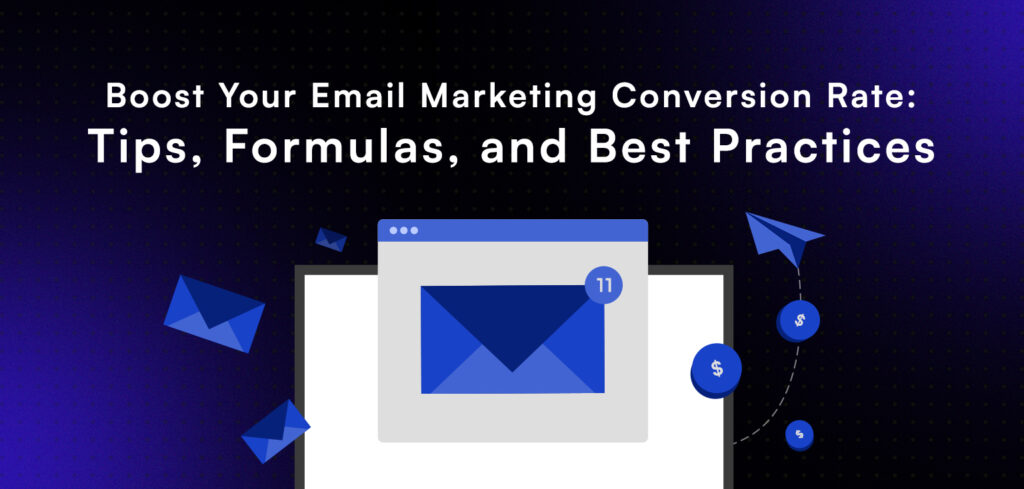Today, email marketing has become a vital tool for brands looking to engage with their audience, build lasting relationships, and ultimately drive conversions. (Cha-ching!)
One of the most critical metrics to measure the success of your email marketing efforts is the email conversion rate. By focusing on improving this key performance indicator, you can maximize the impact of your email marketing campaigns, generate more revenue, and achieve better results for your business.
What Is Email Marketing Conversion Rate?
In email marketing, conversion rate is a metric that measures the percentage of recipients who complete a desired action after receiving your email.
This action could be:
- making a purchase
- filling out a form
- registering for an event
- downloading a resource
- or any other specific goal you’ve set for your campaign.
In essence, it tells you how effective your emails are at persuading your subscribers to take the next step in their customer journey.

How to Calculate Email Conversion Rate
To figure out your email conversion rate, you need to know two things:
- The number of people who took the action you wanted them to take after reading your email (like making a purchase or filling out a form)
- The total number of emails that actually made it to your subscribers’ inboxes
Then, you can plug those numbers into this easy formula:
Email Conversion Rate Formula
Email Conversion Rate = (Number of people who took action / Number of emails delivered) x 100

So, if you sent an email to 500 people and 25 of them did what you wanted them to do, your conversion rate would be:
(25 / 500) x 100 = 5%
It’s important to note that the number of emails delivered may be lower than the total number of emails sent, as some emails may bounce or fail to reach the recipient’s inbox due to factors such as invalid email addresses or full mailboxes.
What Is a Good Conversion Rate for Email Marketing?
It can be tricky to figure out what a good email conversion rate looks like because it depends on a bunch of different factors, such as:
- The industry you’re in
- The people you’re trying to reach
- The kind of email campaign you’re sending out
- What you’re trying to achieve with your emails
In other words, what’s considered a good conversion rate for one brand might not be the same for another. It’s all about understanding your unique situation and setting goals that make sense for you.
Average Email Conversion Rates
So, what’s a typical conversion rate for different types of email campaigns? Let’s take a look at some benchmarks:

Abandoned Cart Emails
These reminders have an impressive average conversion rate of 18.64%, proving that a gentle nudge can work wonders in getting people to complete their purchases.
Welcome Series Emails
Introductory emails sent to new subscribers have an average conversion rate of 2.35%. While not sky-high, it’s a crucial first step in building relationships and setting the stage for future conversions.
Browse Abandonment Emails
These emails target people who checked out a product but didn’t add it to their cart. With an average conversion rate of 0.81%, they’re a great way to remind potential customers of items they were interested in.
Email Marketing Campaigns
Across all industries, the average conversion rate for general email marketing campaigns is 0.08%. This may vary widely depending on your specific industry and audience.
Keep in mind that these are just benchmarks, and your actual conversion rates may be higher or lower depending on your unique circumstances.
Good Email Conversion Rate
Ultimately, a good email conversion rate is one that meets or exceeds your specific goals and benchmarks. It’s essential to set realistic targets based on your industry standards, historical performance, and the nature of your email campaigns.
Once you have a baseline, continually work to improve your conversion rate over time by implementing best practices and optimizing your email marketing strategy.
How to Boost Your Email Marketing Conversion Rate
To improve your email marketing conversion rate, here are several proven strategies you can implement:
Responsive Email Design
In an era where more than half of all emails are opened on mobile devices, it’s crucial to ensure your emails are optimized for all screen sizes.
By using a responsive email design that adapts to the recipient’s device, you can provide a seamless user experience, improve readability, and increase the likelihood of conversions.

Email Segmentation
Not all subscribers are the same, and sending generic emails to your entire list can lead to low engagement and conversion rates. By segmenting your email list based on subscriber preferences, behavior, demographics, and other relevant criteria, you can send targeted, personalized content that resonates with each group.
This approach helps you deliver the right message to the right people at the right time, increasing the chances of conversion.
Email Subject Line
Your email subject line is the first thing recipients see in their inbox, and it plays a crucial role in determining whether they open your email or not.
To boost your open rates and, consequently, your conversion rates, craft compelling subject lines that grab your subscribers’ attention, pique their curiosity, and clearly communicate the value of your email content.
Use A/B testing to experiment with different subject lines and identify the ones that perform best with your audience.
Read this next: 7 Effective Subject Line Formulas to Boost Your Open Rates
Email Marketing A/B Testing
A/B testing is a powerful technique that allows you to compare two versions of an email element to determine which one performs better.
By testing different aspects of your email campaigns, such as subject lines, content, calls-to-action, images, and layouts, you can gain valuable insights into what resonates with your audience and optimize your emails for higher conversion rates.
Make sure to test one element at a time to accurately measure the impact of each change.
Compelling Email Content
Once you’ve gotten your subscribers to open your email, the next challenge is to keep them engaged and guide them towards taking the desired action. To achieve this, create compelling email content that provides value, addresses your subscribers’ pain points, and clearly communicates the benefits of your offer.
Use a clear, concise, and persuasive writing style, and include visually appealing images and videos to break up the text and make your content more engaging.
Strong Call-to-Action (CTA)
Your call-to-action (CTA) is the critical element that prompts your subscribers to take the next step, whether it’s making a purchase, filling out a form, or downloading a resource. To maximize your conversion rates, make sure your CTA is prominently displayed, visually appealing, and uses action-oriented language that creates a sense of urgency. Experiment with different CTA placements, colors, and phrases to find the combination that works best for your audience.

Landing Page Optimization
Your email conversion rate doesn’t just depend on the quality of your email content; it also relies on the effectiveness of your landing page. When a subscriber clicks on your CTA, they should be directed to a dedicated landing page that is optimized for conversions.
This means having a clear, concise headline, compelling copy, social proof, and a prominent CTA that echoes the one in your email. Make sure your landing page is visually appealing, loads quickly, and provides a seamless user experience across all devices.
Timing and Frequency
The timing and frequency of your email campaigns can also have a significant impact on your conversion rates. Send your emails at times when your subscribers are most likely to engage with them, based on your audience’s preferences and behavior.
Be mindful of the frequency of your emails, as sending too many can lead to subscriber fatigue and unsubscribes, while sending too few can cause your audience to lose interest. Find the right balance by monitoring your engagement metrics and adjusting your email schedule accordingly.
Ready to Boost Your Conversion Rates?
Email marketing conversion rate is a critical metric that reflects the effectiveness of your email campaigns in driving desired actions from your subscribers.
By understanding how to calculate your conversion rate, what constitutes a good benchmark, and which strategies you can employ to improve it, you’ll be well-equipped to create email campaigns that generate tangible results for your business.
Remember to stay up-to-date with the latest email marketing best practices, experiment with new techniques, and always keep your audience’s needs and preferences at the heart of your strategy.


